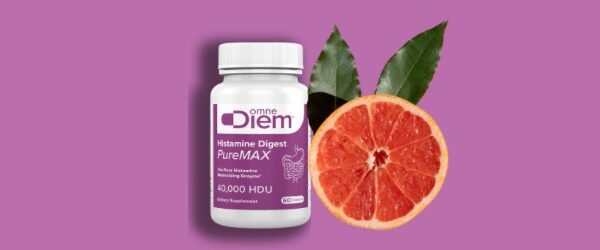
Histamine Intolerance is Not the Same as Allergy! Let Me Tell You Why!
As an integrative and functional nutritionist with special expertise in Histamine Intolerance, I’d like to tell you about Histamine Intolerance and clear up misconceptions.
What is Histamine Intolerance? What are Histamines? What are Mast Cells?
Histamine Intolerance is when there is an imbalance in the amount of accumulated histamine in your body as compared with your body’s capacity to break it down. Histamine Intolerance is also known as HIT. Histamines are chemicals largely produced by a type of white blood cells called mast cells.
Histamines are a key part of your immune system and have a vital role in digestion, sleep, and immune defense. Mast cells have the important job of storing and releasing histamines, however, they sometimes they overreact. When you have a disequilibrium of histamines in your body, it can unleash a cascade of symptoms.
(Mast Cell Activation Syndrome also known as MCAS, is an inappropriate release of ALL mast cell mediators, histamines being just one among them. Histamine Intolerance falls within the larger category of MCAS.)
Histamine Intolerance symptoms are often delayed (unlike allergies), and may take time to manifest. As histamines travel throughout the body through the bloodstream, virtually any part of the body can present with symptoms, from runny nose and itchy eyes, to diarrhea and gastric reflux, to migraine headaches and sleep disorders, to heart arrhythmias and high or low blood pressure, to painful menstrual periods and more!
Clearing Up the Confusion Between Histamine Intolerance and Allergy
One reason for the confusion and difficult diagnosis is that many common symptoms of Histamine Intolerance resemble common allergy symptoms. Histamine Intolerance and some allergic reactions may present similarly. That’s because many allergy symptoms are the result of histamine activity!
As I explain later in this post, tests done by the allergy MD (immunologist) look for a response to a particular antibody and in Histamine Intolerance there is no antibody response!
So when the doctor says, “you are not allergic to XYZ,” it doesn’t mean that your reaction to XYZ isn’t real. It just may be something else, like Histamine Intolerance. which should be explored.
According to the Cleveland Clinic, experts estimate that about 1 in 100 people have Histamine Intolerance. However, since Histamine Intolerance symptoms present differently in each person, the diagnosis of Histamine Intolerance is easily missed. It’s likely that Histamine Intolerance is even more common than 1/100 people.
What are Common Symptoms of Histamine Intolerance?
Symptoms of Histamine Intolerance include:
- Symptoms similar to allergies: runny nose, nose congestion, red and itchy eyes, itchy skin, hives, eczema, asthma, flushing
- Digestive Challenges: diarrhea, nausea, bloating, cramps, gastric reflux
- Nervous System: migraine headaches, fatigue, anxiety, brain fog, sleep disorders
- Cardiovascular Impacts: heart arrhythmia, low blood pressure, high blood pressure
- Women’s Health: painful, heavy menstrual periods
At first glance, many of these symptoms might not appear to be related, but I look for patterns and find that they often are related!
What is a True Allergy (IgE mediated)?
When you go to the allergy doctor, he or she tests for true allergies (IgE mediated). Allergy tests typically look for specific antibodies your immune system produces when it encounters a trigger.
When IgE allergy antibodies are the cause of the reaction to a food, for example, the immune system typically responds almost immediately. The signs and symptoms usually occur within minutes of ingestion, making it much easier to identify the trigger. (An example of this is a peanut allergy.)
Symptoms may include itchy watery eyes, sneezing, runny nose, hives, rashness or redness of the skin, vomiting and in more severe reactions, anaphylaxis.
Why Allergy Tests Don’t Diagnose Histamine Intolerance (HIT)
Even though symptoms of Histamine Intolerance may be similar to allergy symptoms, Histamine Intolerance doesn’t involve antibodies so they are not picked up on the allergy tests.
Also, the onset of symptoms from Histamine Intolerance is usually delayed…hours, sometimes even days, making it much more challenging to identify the triggers.
What is the Histamine “Bucket”?
The histamine bucket refers to each individual’s capacity to handle histamine. When your bucket fills and/or doesn’t drain sufficiently, and then overflows, a person can become symptomatic.
Think of a bucket that’s overflowing or a bathtub that’s not emptying fast enough so the water spills onto the floor, causing a problem. Histamine Intolerance is about keeping histamines in balance. Histamine Intolerance is a functional imbalance.
Histamine Intolerance is when the cumulative amount of histamines in your body (both what you take in through food and what your body produces) is out of balance with your body’s ability to break down histamines. Since there are many variables that increases histamines, and it’s a cumulative effect, what might trigger you one day (think a particular food), may not trigger you another day!
What Are Some of the Causes of Histamine Intolerance?
Food Triggers. (Certain foods can trigger a histamine reaction in more than one way.)
- Some foods contain high levels of histamines,
- Some foods cause histamine to be released within the body,
- Other foods block the enzyme DAO. DAO is the enzyme that degrades or breaks down histamine in the gut.
Alcohol (a big trigger), leftover foods, aged cheeses, fermented products, smoked fish, cured foods, overripe fruit, deli meats, fish (unless it’s extremely fresh), are foods high in histamine and can overfill your the histamine “bucket.”
Medication Triggers. Some medications release histamine or inhibit the DAO enzyme that degrades histamine. These include some antibiotics, anesthetics, opioids, aspirin, NSAIDS, excipients, hormones.
Poor Gut Health. Underlying gut issues and infections can also play a role in causing Histamine Intolerance.
Unhealthy Lifestyle. Stress, poor sleep, smoking all contribute to Histamine Intolerance.
Environmental Triggers. Pollen dust, mold animal dander, pesticides, smog, pigments in makeup, perfumes, radiographic dyes can all trigger histamine release.
Genetic Predisposition. There can be a genetic predisposition to Histamine Intolerance, in particular to have less potential of making the histamine degrading enzyme, DAO.
I do the “detective” work to help identify and remove your personal triggers of histamine intolerance.
Nutrition Tools and Other Treatments for Histamine Intolerance: How to Bring the Histamine”Bucket” Back into Balance
-
- Low Histamine Diet: Identifying and limiting triggers through a low-histamine diet and food diary can significantly reduce symptoms. I work with clients to reduce high histamine foods and eat a low histamine diet to keep the “bucket” from overflowing with too much histamines.
I focus on limiting High Histamine Foods like alcoholic beverages, aged, fermented, cured and smoked products, without overly restricting the diet.But did you know that foods increase in histamine levels as they ripen (think overly ripe fruit), or sit in the refrigerator as leftovers, or sit in supermarket prepared food deli areas for a few days? So the same food freshly made may not trigger a reaction, but it might trigger a reaction after sitting in your home refrigerator or in the store refrigerated section for two or three days! That said, a typically low histamine food can become a high histamine food (and trigger a reaction) when it’s less fresh, leaving the individual totally perplexed.In addition, packaged or processed foods may contain histamine-triggering food additives that would not be present in a homemade version or another brand of the same food. When I work with clients we look at the ingredients in detail to determine any suspect triggers.
- Low Histamine Diet: Identifying and limiting triggers through a low-histamine diet and food diary can significantly reduce symptoms. I work with clients to reduce high histamine foods and eat a low histamine diet to keep the “bucket” from overflowing with too much histamines.
-
- Blood Test for Food and Food-Chemical Sensitivities: If reducing high histamine foods is not enough to relieve symptoms, I also offer testing to uncover hidden food sensitivities that may be contributing to your histamine release.Using the results of the test which identifies your triggers, I design a LEAP eating plan. LEAP is a custom anti-inflammatory eating plan and nutrition counseling program based on the Mediator Release Test (MRT). It is a scientifically based several phase diet that removes identified food and chemical triggers so your immune system can calm down, and then helps you reintroduce safe foods.
-
- DAO Enzyme and Other Nutrition Supplements for Histamine Intolerance: Targeted nutrition supplements are a great tool for helping to stabilize the cells from releasing as much histamine, helping to keep the “bucket” below the “fill line.”In addition, there are supplements that support the two pathways that break down histamines in the body, helping to keep the histamine “bucket” from overflowing. The main pathway in the gut is DAO (Diamine oxidase) which can be taken as a supplement. The second pathway in the other parts of the body is HNMT which requires several nutrition cofactors to operate optimally.
-
- Restore Gut Health for Histamine Intolerance: I work with clients to heal their gut lining and support a healthy, balanced, and diverse microbiome to maintain a healthy gut lining, reduce inflammation and keep histamine levels in check.
-
- Changing Lifestyle Makes a Difference with Histamine Intolerance: We discuss ways to help manage stress, optimize sleep, and avoid smoking – all factors can aggravate your histamine response.
Key Takeaways for Managing Histamine Intolerance
Histamine Intolerance (HIT) and allergy are commonly confused, but understanding the distinct players, such as DAO and HNMT enzymes and mast cells, is crucial. Unlike allergies, HIT is a functional imbalance where the histamine “bucket” overflows, leading to delayed symptoms. Standard allergy tests are ineffective for HIT.
- Identify Your Own Histamine Intolerance Triggers: I work with clients to start learning their trigger foods that may fill their histamine “bucket.” We start by keeping a food diary, and then may go on to an elimination diet, or get a food sensitivity test for deeper insights. I am a Certified LEAP Therapist (CLT) and Functional Registered Dietitian Nutritionist, trained to evaluate the MRT food sensitivity test and implement the immune calming diet.
- Build a Stronger “Bucket” to Keep Your Histamines in Balance: Heal your gut lining, support your microbiome, and prioritize sleep and stress management to bolster your body’s natural histamine processing abilities.
- Tailor Your Strategies for Keeping Histamine at a Good Level: The right tools for your “bucket” might include a low-histamine diet, DAO enzyme supplements, gut health supplements, and individual lifestyle adjustments. I work with clients to help them listen to your bodies and personalize strategies to find what works best for each individual.
How I Can Help You If You are Having Histamine Intolerance Symptoms
1. SHOP Top Recommended Supplements for Histamine Intolerance
- DAO,
- DAO PureMax
- Quercetin,
- Natural D-Hist,
- Megasporebiotic,
- Megasporebiotic Gummies,
- Vitamin C,
- Petadolex (especially for migraine symptoms).
2. Schedule an Appointment or MRT Food Sensitivity Test
Contact Me for Personalized Guidance on Managing Your Histamine Intolerance (HIT). Histamine Intolerance can present in many ways. It’s best to work with a healthcare practitioner like myself who is experienced and has a track record with Histamine Intolerance.
3. Learn More About My Approach to Managing Your Histamine Intolerance Symptoms
Take control of your histamine journey. Histamine Intolerance doesn’t have to control your life. By understanding your triggers, implementing the right changes, and adopting a holistic approach to your health, you can achieve balance and experience a life free from uncomfortable symptoms.
Remember, you’re not alone in this journey. As your certified LEAP Therapist and Functional Registered Dietitian Nutritionist, I’m here to guide and support you every step of the way. Ready to take control of your health and reclaim your life?




